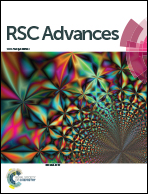Preparative separation of alkaloids from Litsea cubeba using combined applications of pH-zone-refining and high-speed counter-current chromatography
Abstract
Litsea cubeba is characterized by the presence of aporphine alkaloids. But few recent reports about the preparative separation of alkaloids from L. cubeba are found. The traditional separation method is time consuming and solvent consuming and irreversible adsorption is inevitable. In this research, pH-zone-refining counter-current chromatography and high-speed counter-current chromatography are applied to separate the alkaloids from a chloroform extract of L. cubeba. The crude extract was fractionated using the solvent system: chloroform–methanol–water (4 : 3 : 3, v/v) with different concentrations of hydrochloric acid (retainer) in the aqueous stationary phase and triethylamine (eluter) in the organic mobile phase to determine the ideal conditions for screening for the aporphine alkaloids. Using 1.5 g of the chloroform extract, 68.1 mg of norisocorydine (93.5% purity), 215.5 mg of isoboldine (96.3% purity), 612.3 mg of the mixture of boldine and laurotetanine, 108.8 mg of reticuline (97.4% purity) and 92.6 mg of laurolitsine (97.6% purity) were obtained with the selected conditions where 60 mM of hydrochloric acid was added to the stationary phase and 10 mM of triethylamine was used in the mobile phase. The mixture of boldine and laurotetanine was further separated using high-speed counter-current chromatography with a two-phase solvent system composed of ethyl acetate–methanol–water (4 : 1 : 5, v/v). Two alkaloids, laurotetanine (285.7 mg) and boldine (112.3 mg), were obtained from 500 mg of the mixture, in a one-step separation, with the relative purity of 94.8% and 96.2%, respectively. The purities of the isolated alkaloids were determined using high performance liquid chromatography and the chemical structures were confirmed using electrospray ionization-mass spectrometry, proton nuclear magnetic resonance (1H-NMR) and carbon-13 (13C)-NMR.


 Please wait while we load your content...
Please wait while we load your content...